
Concept explainers
. Give the systematic name for each of the following alcohols. Indicate whether the alcohol is primary, secondary, or tertiary.
a. 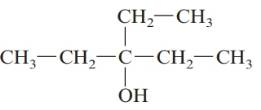
b. 
c. 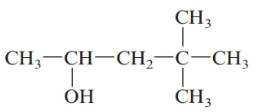
d. 
Interpretation:
The systematic names of the given alcohol and whether it is primary, secondary, or tertiary alcohol should be determined.
Concept Introduction:
An organic compound in which hydroxyl functional group that is -OH is bonded to the carbon atom is said to be an alcohol. The general formula for alcohol is Cn H2 n + 1 OH. Based on the attachment to the carbon the alcohols are classified as primary, secondary, or tertiary alcohol.
When alcohol (having hydroxyl group) is attached to a primary carbon atom (carbon atom to which one carbon atom is attached) then such alcohol is said to be a primary alcohol.
When alcohol (having hydroxyl group) is attached to a secondary carbon atom (carbon atom to which two carbon atoms are attached) then such alcohol is said to be a secondary alcohol.
When alcohol (having hydroxyl group) is attached to a tertiary carbon atom (carbon atom to which three carbon atoms are attached) then such alcohol is said to be a tertiary alcohol.
In order to give the name to the alcohol following steps are followed:
1. The parent (longest) continuous carbon chain containing hydroxyl group (-OH) is selected.
2. While writing the name of alcohol, the suffix "e" of the corresponding alkane is replaced by "-ol".
3. Name should be written in alphabetical order and numbering should be done in such a way that the multiple bond and substituent group gets lowest number.
4. Hyphen is used to connect the number to the name.
For number of carbons atoms in alkane chain, the prefix is given as:
Carbon-1 meth
Carbon-2 eth
Carbon-3 prop
Carbon-4 but
Carbon-5 pent
Carbon-6 hex
Carbon-7 hept
Carbon-8 oct
Carbon-9 non
Carbon-10 dec.
Answer to Problem 61QAP
3-ethylpentan-3-ol; tertiary alcohol.
Explanation of Solution
The given structure is:

The parent chain in the given structure is of 5-carbon atoms so, prefix will be pent. Numbering is done in such a way that the hydroxyl group gets lower number that is 3 and the ethyl substituent also get 3.

So, the IUPAC name will be: 3-ethylpentan-3-ol.
Since, -OH group is attached to tertiary carbon so, it is tertiary alcohol.
Interpretation:
The systematic names of the given alcohol and whether it is primary, secondary, or tertiary alcohol should be determined.
Concept Introduction:
An organic compound in which hydroxyl functional group that is -OH is bonded to the carbon atom is said to be an alcohol. The general formula for alcohol is Cn H2 n + 1 OH. Based on the attachment to the carbon the alcohols are classified as primary, secondary, or tertiary alcohol.
When alcohol (having hydroxyl group) is attached to a primary carbon atom (carbon atom to which one carbon atom is attached) then such alcohol is said to be a primary alcohol.
When alcohol (having hydroxyl group) is attached to a secondary carbon atom (carbon atom to which two carbon atoms are attached) then such alcohol is said to be a secondary alcohol.
When alcohol (having hydroxyl group) is attached to a tertiary carbon atom (carbon atom to which three carbon atoms are attached) then such alcohol is said to be a tertiary alcohol.
In order to give the name to the alcohol following steps are followed:
1. The parent (longest) continuous carbon chain containing hydroxyl group (-OH) is selected.
2. While writing the name of alcohol, the suffix "e" of the corresponding alkane is replaced by "-ol".
3. Name should be written in alphabetical order and numbering should be done in such a way that the multiple bond and substituent group gets lowest number.
4. Hyphen is used to connect the number to the name.
For number of carbons atoms in alkane chain, the prefix is given as:
Carbon-1 meth
Carbon-2 eth
Carbon-3 prop
Carbon-4 but
Carbon-5 pent
Carbon-6 hex
Carbon-7 hept
Carbon-8 oct
Carbon-9 non
Carbon-10 dec.
Answer to Problem 61QAP
2, 4-dimethylpentan-3-ol; secondary alcohol.
Explanation of Solution
The given structure is:
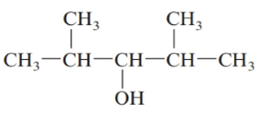
The parent chain in the given structure is of 5-carbon atoms so, prefix will be pent. Numbering is done in such a way that the hydroxyl group gets lower number that is 3 and the methyl substituent on 2 and 5.

So, the IUPAC name will be: 2, 4-dimethylpentan-3-ol.
Since, -OH group is attached to secondary carbon so, it is secondary alcohol.
Interpretation:
The systematic names of the given alcohol and whether it is primary, secondary, or tertiary alcohol should be determined.
Concept Introduction:
An organic compound in which hydroxyl functional group that is -OH is bonded to the carbon atom is said to be an alcohol. The general formula for alcohol is Cn H2 n + 1 OH. Based on the attachment to the carbon the alcohols are classified as primary, secondary, or tertiary alcohol.
When alcohol (having hydroxyl group) is attached to a primary carbon atom (carbon atom to which one carbon atom is attached) then such alcohol is said to be a primary alcohol.
When alcohol (having hydroxyl group) is attached to a secondary carbon atom (carbon atom to which two carbon atoms are attached) then such alcohol is said to be a secondary alcohol.
When alcohol (having hydroxyl group) is attached to a tertiary carbon atom (carbon atom to which three carbon atoms are attached) then such alcohol is said to be a tertiary alcohol.
In order to give the name to the alcohol following steps are followed:
1. The parent (longest) continuous carbon chain containing hydroxyl group (-OH) is selected.
2. While writing the name of alcohol, the suffix "e" of the corresponding alkane is replaced by "-ol".
3. Name should be written in alphabetical order and numbering should be done in such a way that the multiple bond and substituent group gets lowest number.
4. Hyphen is used to connect the number to the name.
For number of carbons atoms in alkane chain, the prefix is given as:
Carbon-1 meth
Carbon-2 eth
Carbon-3 prop
Carbon-4 but
Carbon-5 pent
Carbon-6 hex
Carbon-7 hept
Carbon-8 oct
Carbon-9 non
Carbon-10 dec.
Answer to Problem 61QAP
4, 4-dimethylpentan-2-ol; secondary alcohol.
Explanation of Solution
The given structure is:
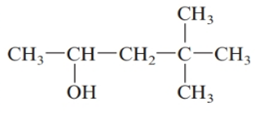
The parent chain in the given structure is of 5-carbon atoms so, prefix will be pent. Numbering is done in such a way that the hydroxyl group gets lower number that is 2 and the methyl substituent on carbon number 4.

So, the IUPAC name will be: 4, 4-dimethylpentan-2-ol.
Since, -OH group is attached to secondary carbon so, it is secondary alcohol.
Interpretation:
The systematic names of the given alcohol and whether it is primary, secondary, or tertiary alcohol should be determined.
Concept Introduction:
An organic compound in which hydroxyl functional group that is -OH is bonded to the carbon atom is said to be an alcohol. The general formula for alcohol is Cn H2 n + 1 OH. Based on the attachment to the carbon the alcohols are classified as primary, secondary, or tertiary alcohol.
When alcohol (having hydroxyl group) is attached to a primary carbon atom (carbon atom to which one carbon atom is attached) then such alcohol is said to be a primary alcohol.
When alcohol (having hydroxyl group) is attached to a secondary carbon atom (carbon atom to which two carbon atoms are attached) then such alcohol is said to be a secondary alcohol.
When alcohol (having hydroxyl group) is attached to a tertiary carbon atom (carbon atom to which three carbon atoms are attached) then such alcohol is said to be a tertiary alcohol.
In order to give the name to the alcohol following steps are followed:
1. The parent (longest) continuous carbon chain containing hydroxyl group (-OH) is selected.
2. While writing the name of alcohol, the suffix "e" of the corresponding alkane is replaced by "-ol".
3. Name should be written in alphabetical order and numbering should be done in such a way that the multiple bond and substituent group gets lowest number.
4. Hyphen is used to connect the number to the name.
For number of carbons atoms in alkane chain, the prefix is given as:
Carbon-1 meth
Carbon-2 eth
Carbon-3 prop
Carbon-4 but
Carbon-5 pent
Carbon-6 hex
Carbon-7 hept
Carbon-8 oct
Carbon-9 non
Carbon-10 dec.
Answer to Problem 61QAP
2, 2, 4-trimethylpentan-1-ol; primary alcohol.
Explanation of Solution
The given structure is:

The parent chain in the given structure is of 5-carbon atoms so, prefix will be pent. Numbering is done in such a way that the hydroxyl group gets lower number that is 1 and the methyl substituents on carbon number 2 and 4.
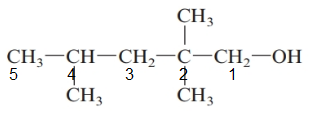
So, the IUPAC name will be: 2, 2, 4-trimethylpentan-1-ol.
Since, -OH group is attached to primary carbon so, it is primary alcohol.
Want to see more full solutions like this?
Chapter 20 Solutions
Introductory Chemistry: A Foundation
Additional Science Textbook Solutions
Organic Chemistry
Organic Chemistry (9th Edition)
Chemistry: The Central Science (14th Edition)
Chemistry: An Introduction to General, Organic, and Biological Chemistry (12th Edition) - Standalone book
General, Organic, and Biological Chemistry - 4th edition
Essential Organic Chemistry (3rd Edition)
- The general formula of an alkane is CnH2n+2 . What is the general formula of an (a) alkene? (b) alkyne? (c) alcohol derived from an alkane?arrow_forwardThe correct structural for ethyne is: a. HC=CH b. HC=C=H c. HCCH d. H=C=C=Harrow_forwardUse the generic formula for alkanes (CnH2n+2) to derive molecular and condensed structural formulas for: a. Propane, 3 carbon atoms b. Octane, 8 carbon atoms c. Butane, 4 carbon atomsarrow_forward
- What kinds of reactions are common to alkanes? List an example of each.arrow_forwardOrganic molecules in living things have molecular weights of thousands or millions of atomic mass units (u) and are therefore referred to as: A) macromolecues B) cyclic monomers C) esters D) kerosenes WHICH ONE IS IT PLEASE HELP ME KNOWarrow_forwardGive some other uses of alkanes.arrow_forward
 ChemistryChemistryISBN:9781305957404Author:Steven S. Zumdahl, Susan A. Zumdahl, Donald J. DeCostePublisher:Cengage Learning
ChemistryChemistryISBN:9781305957404Author:Steven S. Zumdahl, Susan A. Zumdahl, Donald J. DeCostePublisher:Cengage Learning
 Chemistry: An Atoms First ApproachChemistryISBN:9781305079243Author:Steven S. Zumdahl, Susan A. ZumdahlPublisher:Cengage Learning
Chemistry: An Atoms First ApproachChemistryISBN:9781305079243Author:Steven S. Zumdahl, Susan A. ZumdahlPublisher:Cengage Learning- Chemistry: Matter and ChangeChemistryISBN:9780078746376Author:Dinah Zike, Laurel Dingrando, Nicholas Hainen, Cheryl WistromPublisher:Glencoe/McGraw-Hill School Pub Co
 Introductory Chemistry: An Active Learning Approa...ChemistryISBN:9781305079250Author:Mark S. Cracolice, Ed PetersPublisher:Cengage Learning
Introductory Chemistry: An Active Learning Approa...ChemistryISBN:9781305079250Author:Mark S. Cracolice, Ed PetersPublisher:Cengage Learning Chemistry: Principles and ReactionsChemistryISBN:9781305079373Author:William L. Masterton, Cecile N. HurleyPublisher:Cengage Learning
Chemistry: Principles and ReactionsChemistryISBN:9781305079373Author:William L. Masterton, Cecile N. HurleyPublisher:Cengage Learning





